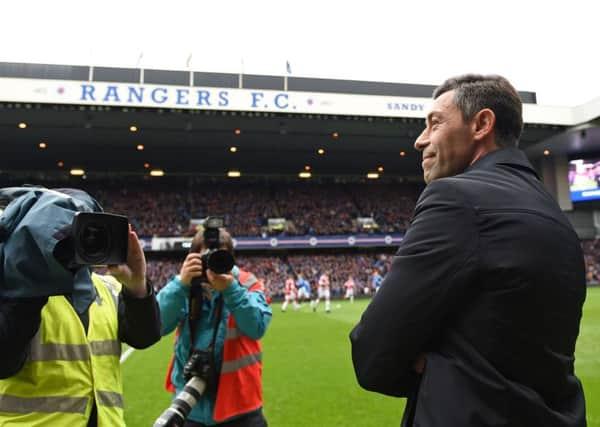Five changes Pedro Caixinha made to Rangers' play
This article contains affiliate links. We may earn a small commission on items purchased through this article, but that does not affect our editorial judgement.


Everything in this article must be considered with the massive caveat: it was against Hamilton.
Advertisement
Hide AdAdvertisement
Hide AdThat may seem unfair on Accies. After all, they did draw at Ibrox in the very first game of the league campaign. But this version of Hamilton is a shell of that team. They were low on confidence, low on form (they’d lost their previous two games by a combined 10-0), and low on personnel without captain Michael Devlin and first-choice striker Alex D’Acol, who returned to the squad but was only fit enough for a place on the bench.
If Pedro Caixinha could have drawn up his own fixture list to start his Ibrox career he could barely have picked a better opponent. The same can be said for the following games, which sees a similarly struggling Motherwell side visit Ibrox. It’s the perfect opportunity for the Portuguese head coach, who was a surprising choice to succeed Mark Warburton, build up some early momentum.
Hamilton also played right into Rangers’ hands as the hosts took full advantage of the visitors’ 5-3-1-1 formation that featured no natural striker and a lack of sufficient cover on the wings to curtail the runs of James Tavernier and Lee Wallace. The two full-backs would be an integral part of the Ibrox side’s success in this game. It was one of very few familiar aspects of their play from Warburton’s tenure, as Caixinha wasted no time in stamping his own mark on the side.
Formation change
Graeme Murty fiddled around with the line-up at times but ultimately decided the 4-3-3 was the best use of Rangers’ personnel. Caixinha didn’t seem to agree. The hosts lined-up in a 4-4-2 right from the off. Kenny Miller and Martyn Waghorn formed a strike-partnership rather than rotating between striker and right midfield, which is what they used to do under Warburton. It seemed to bring the best out of the pair. Waghorn, in particular, had his best game for months, terrorising the Accies back-line and notching a goal (from a penalty he won) and an assist.
In midfield Jon Toral and Jason Holt made up a rather slight but effective central duo, with help from Emerson Hyndman drifting in from the right. The centre midfielder’s natural inclination to move inside stopped the hosts from becoming overrun in that area.
It’ll be intriguing to see if Caixinha sticks with the line-up against more adventurous opponents and how it’ll work, or whether he plans to switch formations from match to match.
Going direct
In the first minute of Saturday’s game, Danny Wilson reared back and fired a pass 40 yards up field to Martyn Waghorn, which would ultimately lead to a Barrie McKay shot from 18 yards. It was a statement of intent from the new-look side. They didn’t spend all game lumping balls into the striker, but it was an option they were willing to use more readily than under the previous regime.
They would also take more chances in possession. Instead of looking to keep the ball first and foremost, they would attempt a tricky through ball where, a few weeks ago, they would’ve been reticent to do so.
Upping the tempo
Advertisement
Hide AdAdvertisement
Hide AdThere was still a lot of short play designed to move around Hamilton in triangular patterns, not to mention an emphasis on pressing the opponents in possession, hurrying them into making slack passes which allowed the home side to quickly re-take hold of the football.
By design this wasn’t anything new compared with Warburton’s philosophy, the players just implemented it better. They showed much more urgency in this match than they had across the previous 12 months.
The quicker you move the football the easier it is to take advantage of the holes created by the opponent’s formation. Tavernier and Wallace were able to have so much joy because, instead of ponderously moving the play, allowing Hamilton to cover space, the ball was zipping out wide where the full-backs could team with Hyndman or McKay to create a two-on-one advantages against the Accies full-back.
As for the pressing game, it was certainly turned up a few notches. Whether this was a case of a team desperate to impress the new manager, or a new method of training which enables the players to use their pressing more effectively, remains to be seen. We’ll find out over the coming weeks.
Using Foderingham exclusively as a goalkeeper
If any player at Rangers should be loving the change of manager, it’s Wes Foderingham, even if Warburton brought him to the club. Throughout his Ibrox tenure he’s been asked to play the role of sweeper-keeper, despite the fact it’s abundantly clear that it is not a strength of his game. If Saturday’s match is anything to go by, he’s finally able to concentrate fully on his most important role: stopping the other team from putting the ball in the net.
Organisation at set-pieces
Rangers have often been critcised for their lack of defensive shape and disorganisation at set-pieces. Even though it was just one game, we already saw evidence of that not being the case under Caixinha. Not only did Rangers try out a couple of rehearsed set-piece moves in attack, they also looked more defensively structured when defending them, as Clint Hill and company kept a solid line to deal with Accies’ aerial threat.